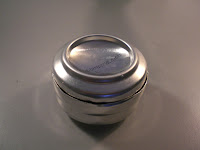
In the past week, Mike and I have been brewing and bottling Beezo Brau. A (hopefully) delicious blend of malt extract, hops, water, and yeast. Mike found the recipe at Brew Your Own magazine online. It seemed simple enough so we went out two Saturdays ago, got lit up at the BLB for breakfast and went to the home brew store in St. Louis Park. We were poking around to collect the items on our list (which happened to be several photographs of my whiteboard).
Neither of us had any idea how the whole thing was set up so I couldn't visualize what it was going to look like. We were poking around, dodging the salesman who kept trying to be helpful, but we were too committed to the lie that we knew anything about beer brewing. We were looking at glass carboys when a sales woman came up and said she could have it sent up to the front if we wanted it. We looked at each other, then back at her, and said, "we'll take it." At that point we were committed, and started snapping up everything on our list. We got out of there and back to Mike's before we realized we didn't have a stopper or a racking cane. I returned to the store only to find it closed at half hour earlier (3:00). By a happy dumb luck I had picked an Ale Pail as our bucket, whose lid had a stoppered hole in it.
 So we heated the water, added the malt extract, and stirred it up good in the steel kettle on high heat. Once it hit a boil, we dumped the Golding hops, stirred and enjoyed the delicious, earthy aromas. After a turn, we blasted the wort with finishing hops, and jammed the bastard into an ice bath in Mike's sink. That worked like shit, so we put the whole kettle in the freezer.
So we heated the water, added the malt extract, and stirred it up good in the steel kettle on high heat. Once it hit a boil, we dumped the Golding hops, stirred and enjoyed the delicious, earthy aromas. After a turn, we blasted the wort with finishing hops, and jammed the bastard into an ice bath in Mike's sink. That worked like shit, so we put the whole kettle in the freezer.We needed to cool down to around 70F before aerating it, pitching the yeast, and capping it in the ail pail with an airlock. So we hung out and sterilized all of the gear we were going to use. Built a couple of beer funnels, called Bingers, to remind us of day gone by. Did up the beer and done.

Skip ahead a week.
First of all, the Friday before hand, we got caught up with the good doctor V in a whirlwind of happy hours, then to my place to try out the Binger, then to Mike's to get his Binger, then back to the Good Doctor's, where we proceeded to relive the frat life we'd never lived. SigTranDelt is by far the worst fraternity on the face of the planet, but the people are cool. So you can imagine how we felt on Saturday...
 Barely able to move, difficulty with daylight, waves of nausea - thankfully the BLB cured al that with delicious breakfast, and we were back to the beer store for an auto-siphon rather than racking cane, stopper, and more ingredients.
Barely able to move, difficulty with daylight, waves of nausea - thankfully the BLB cured al that with delicious breakfast, and we were back to the beer store for an auto-siphon rather than racking cane, stopper, and more ingredients.The sterilization proved to be a huge bitch this time because
 everything that the beer comes in contact with has to be soaked in bleach solution and that meant 48 bottles, buckets, little hoses, etc. Pain in the ass. But we got it done. The siphoning turned out to be a little tricky, but it was mainly just slow. We got 41 bottles. And have to wait till a week Wednesday to try them...
everything that the beer comes in contact with has to be soaked in bleach solution and that meant 48 bottles, buckets, little hoses, etc. Pain in the ass. But we got it done. The siphoning turned out to be a little tricky, but it was mainly just slow. We got 41 bottles. And have to wait till a week Wednesday to try them... After that, we moved the whole operation to my place, and brewed up another batch - this time with different ingredients - same recipe. It's sitting in my kitchen, now, gurgling...
After that, we moved the whole operation to my place, and brewed up another batch - this time with different ingredients - same recipe. It's sitting in my kitchen, now, gurgling...


























